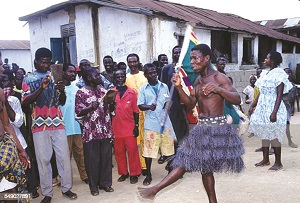
It is a mark of our lack of confidence in our nationhood that whilst looking around for a solution to the problem caused to the survival of our country as a nation by galamsey, we have not explored home-made remedies.
I mean the system which our ancestors relied upon to create stable societies that were relatively free of anti-social crimes.
There is hardly any village in Ghana in which there isn’t a system for tackling emergencies. If people go to their farms and do not return at the appointed time; if people from one village travel to another and are not back at the time they had said they would return; if a river overflows its banks and threatens the lives of those who need to cross it to continue earning their living; as well as in many other similar emergencies every village and town posses the INHERITED SOCIAL MACHINERY with which to tackle the particular emergency.
Each ethnic group in Ghana has its own system (though many overlap: in the sense that they are similar systems with the same objectives, although the systems may have different nomenclatures or organisational structures.).
In the Akan society in which I was raised (and please pardon me for talking about what I know!) the body responsible for tackling emergencies is called the ASAFO, or KYIREM group.
The Asafo is headed by an Asafohene, who sits at the apex of a structure evolved along military lines. The most important elements of the structure are the drummers group and the intelligence-gathering group (Akwansrafo).
The main body of the Asafo of the mass of the community, each with its own family head or Opanin. In an emergency, the kyirem drums are beaten, and each Opanin summons his family members to meet him at his house. They talk there for a while, and then they all troop to the Chief’s palace orAhenfie. This process is, of course, duplicated in each family,
At the palace, they are informed of the type of emergency that has occurred, and they discuss ways of tackling it. If they need tools or facilities that are not immediately available to them, they send word top the Chief, who might have some ideas. When they are satisfied that they have the means of combating the emergency, they set out for the bush.
When I was a child I saw this group in action. A woman called AfiaMframa went to her farm and getting towards nightfall, her kinsfolk noticed that she had not come back. The alarm was raised and the family head went to tell the chief drummer of the Asafo and the drums were beaten.
Within half an hour, the Chief’s palace had completely filled with people. Everyone who heard the particular Asafo drums that were played that afternoon, knew that something “dangerous” had happened. The nature of the danger was spelt out openly and people from MaameAfiaMframa’s family were asked to lead the group to go to her farm.
It took them just about an hour to find her body – she had been struck down by the branch of a tree, following a strong wind.
They picked up the body, wrapped it up and gave it to two young men from her family to carry. They then began singing war songs and came back to the village – to be met by everyone, including us, the children. The older people prevented us from going too close to the carriers of the body. It was deemed that children should not be exposed to the trauma of seeing the awful things that could happen to the human body.
The Asafo then divided itself into two groups – one to take the dead body to the mortuary at Kyebi, seven miles away, where there was also a Government police station, where the matter could be reported. (There was a “Native Authority” police station at my town, Asiakwa, but it did not handle serious issues like death by accident.) The other group held a wake for ther dead woman.
Fortunately for me, this was the only emergency I saw with my own eyes when I was growing up. But other emergencies I heard about occurred, for instance, during times when timber merchants came into our forest to cut down timber trees, ruining many of the roads that led to our cocoa and food farms. The timber cutters came with sawyers, who dug holes in our farms, put huge logs across them, and cut them into boards before transporting them off to wherever they came from.
The issues of what the sawyers did to farmlands; what food crops were destroyed by the felling of timber; and other ancillary problems, were all discussed by the Asafo in public and their demands for acts of amelioration, including cash compensation paid to those affected, agreed to and implemented.
The Asafo was therefore the backbone of our entire traditional society. It was also through the Asafothat, if a Chief went against his oath to serve the interests of the people, proceedings could be taken to bring him to order, and eventually lead to his destoolment, if he did not reform.
Because of the role the Asafos played in destooling unpopular Chiefs, some Chiefs complained about them to the District Commissioners (appointed by the colonial government, whose measures were absorbed or imitated by our governments after independence!) and quite often, Government police forces were brought into troubled areas to ensure that Government interests were preserved (as against the people’s demands for specific actions with which a Chief might not have agreed.)
As soon as a split occurred between a Chief and his people and the Central Government intervened, the Asafo would begin a journey into eventual decline.Alas, that has happened only too often in the recent past. Both the Chiefs and their people ought to rediscover their past methods of co-operation and organise themselves to save Ghana from a future in which our chikdren and their grandchildren will have no hygienic water to drink.
This is why virile Asafo groups have largely vanished from our country. True, there are a few which have retained their strength for years (such as the Asafo groups that catch deer at the Aboakyirfestival of Winneba.) But even they are a shadow of themselves these days.
If the Government is really serious about ending the galamsey menace, it must vote a sum of money to the traditional authorities to revive their Asafo or similar groups.
_
By the way a historical note: it was what he saw during a British invasion of Asante, regarding how the Asafo were organised to defend their people against the British (especially their methods of gathering intelligence about the enemy and their ability to inflict serious sabotage on him) that convinced Sir Robert Baden Powell of Great Britain to give birth to “Boy Scouts” movement!
I shall spell out more practical methods for reviving the Asafos and unleashing them on the galamseyers, in future articles. I urge readers who have views on this subject to write Letters to The Editor discussing them. Please, our country need these ideas badly!
By CAMERON DUODU



